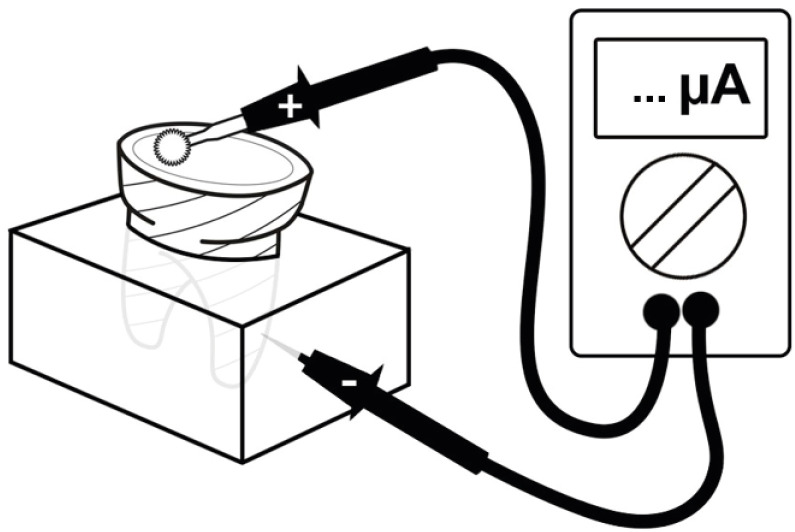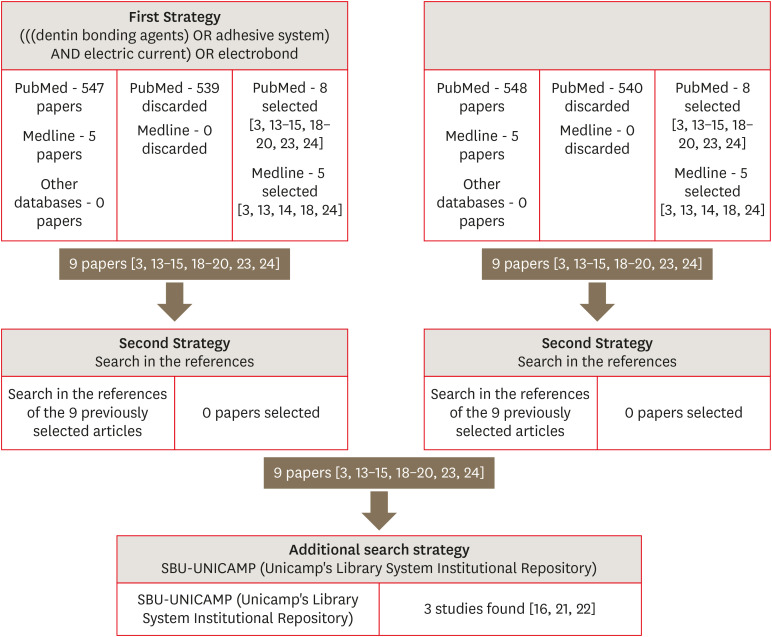Restor Dent Endod.
2021 Nov;46(4):e55. 10.5395/rde.2021.46.e55.
Adhesive systems applied to dentin substrate under electric current: systematic review
- Affiliations
-
- 1Postgraduate Program in Dentistry, School of Dentistry, Department of Prosthodontics, University of Taubate, Taubaté, SP, Brazil
- 2School of Dentistry, Department of Dentistry, University Tiradentes, Aracaju, SE, Brazil
- 3School of Dentistry, Department of Dentistry, Herminio Ometto University Center, Araras, SP, Brazil
- KMID: 2548099
- DOI: http://doi.org/10.5395/rde.2021.46.e55
Abstract
Objectives
The purpose of this systematic review was to collect and discuss the technique of adhesive systems application on dentin substrate under electric current.
Materials and Methods
The first search strategy was based on data available at PubMed, LILACS, Scielo, Scopus, and Cochrane Library, using a combination of descriptors such as “dentin bond agents OR adhesive system AND electric current OR electrobond” or “dentin bonding agents OR dentin bonding agent application OR adhesive system AND electric current OR electrobond”, with no limit regarding the publication year. The second search strategy was based on the articles' references found previously. An additional search strategy was applied that concerned the proposed theme in the SBU-UNICAMP (Unicamp's Library System Institutional Repository).
Results
Twelve studies published between 2006 and 2020 were found. The analyses of the selected studies showed that the use of electric current during adhesive systems application on dentin, whether conventional or self-conditioning, increases resinous monomer infiltration in the dentin substrate, which improves the hybridization processes and the bond strength of the restorative material to dentin.
Conclusions
Despite the favorable results related to the use of this technique, there is still no specific protocol for the application of adhesive systems under electric current.
Figure
Reference
-
1. Gale MS, Darvell BW. Thermal cycling procedures for laboratory testing of dental restorations. J Dent. 1999; 27:89–99. PMID: 10071465.
Article2. Carrilho MR, Carvalho RM, de Goes MF, di Hipólito V, Geraldeli S, Tay FR, Pashley DH, Tjäderhane L. Chlorhexidine preserves dentin bond in vitro . J Dent Res. 2007; 86:90–94. PMID: 17189470.3. Breschi L, Mazzoni A, Pashley DH, Pasquantonio G, Ruggeri A, Suppa P, Mazzotti G, Di Lenarda R, Tay FR. Electric-current-assisted application of self-etch adhesives to dentin. J Dent Res. 2006; 85:1092–1096. PMID: 17122160.
Article4. Cadenaro M, Antoniolli F, Sauro S, Tay FR, Di Lenarda R, Prati C, Biasotto M, Contardo L, Breschi L. Degree of conversion and permeability of dental adhesives. Eur J Oral Sci. 2005; 113:525–530. PMID: 16324144.
Article5. Hashimoto M, Tay FR, Ito S, Sano H, Kaga M, Pashley DH. Permeability of adhesive resin films. J Biomed Mater Res B Appl Biomater. 2005; 74:699–705. PMID: 15973690.
Article6. Hebling J, Pashley DH, Tjäderhane L, Tay FR. Chlorhexidine arrests subclinical degradation of dentin hybrid layers in vivo . J Dent Res. 2005; 84:741–746. PMID: 16040733.
Article7. Ito S, Tay FR, Hashimoto M, Yoshiyama M, Saito T, Brackett WW, Waller JL, Pashley DH. Effects of multiple coatings of two all-in-one adhesives on dentin bonding. J Adhes Dent. 2005; 7:133–141. PMID: 16052762.8. King NM, Tay FR, Pashley DH, Hashimoto M, Ito S, Brackett WW, García-Godoy F, Sunico M. Conversion of one-step to two-step self-etch adhesives for improved efficacy and extended application. Am J Dent. 2005; 18:126–134. PMID: 15973833.9. Osorio R, Erhardt MC, Pimenta LA, Osorio E, Toledano M. EDTA treatment improves resin-dentin bonds' resistance to degradation. J Dent Res. 2005; 84:736–740. PMID: 16040732.
Article10. Pashley DH, Agee KA, Carvalho RM, Lee KW, Tay FR, Callison TE. Effects of water and water-free polar solvents on the tensile properties of demineralized dentin. Dent Mater. 2003; 19:347–352. PMID: 12742428.
Article11. Van Landuyt KL, De Munck J, Snauwaert J, Coutinho E, Poitevin A, Yoshida Y, Inoue S, Peumans M, Suzuki K, Lambrechts P, Van Meerbeek B. Monomer-solvent phase separation in one-step self-etch adhesives. J Dent Res. 2005; 84:183–188. PMID: 15668338.
Article12. G Pasquantonio L Breschi A Petrone . Method and device for preparing the hard structures of teeth for the application of dental restorative materials. United States patent. US-0973879. 2001. 06. 29.13. Mazzoni A, Visintini E, Vita F, Pasquantonio G, Saboia VP, Ruggeri A Jr, Di Lenarda R, Dorigo E, Breschi L. ElectroBond improves immediate dentin microtensile bond strength of two etch-and-rinse adhesives. J Adhes Dent. 2009; 11:27–33. PMID: 19343924.14. Toledano M, Mazzoni A, Monticelli F, Breschi L, Osorio E, Osorio R. ElectroBond application may improve wetting characteristics of etched dentine. J Dent. 2011; 39:180–186. PMID: 21126555.
Article15. Pasquantonio G, Tay FR, Mazzoni A, Suppa P, Ruggeri A Jr, Falconi M, Di Lenarda R, Breschi L. Electric device improves bonds of simplified etch-and-rinse adhesives. Dent Mater. 2007; 23:513–518. PMID: 16678247.
Article16. Guarda MB. Influence of electric current on diffusion of adhesive systems on different substrates [dissertation]. Piracicaba, SP: School of Dentistry, University of Campinas;2016.17. McKenzie JE, Brennan SE, Ryan RE, Thomson HJ, Johnston RV, Thomas J. Chapter 3: Defining the criteria for including studies and how they will be grouped for the synthesis. Higgins JPT, Thomas J, Chandler J, Cumpston M, Li T, Page MJ, Welch VA, editors. Cochrane Handbook for Systematic Reviews of Interventions version 6.1 (updated September 2020). London: Cochrane;2020.18. Chen H, Fu D, Yang H, Liu Y, Huang Y, Huang C. Optimization of direct currents to enhance dentine bonding of simplified one-step adhesive. Eur J Oral Sci. 2014; 122:286–292. PMID: 24965668.
Article19. Visintini E, Mazzoni A, Vita F, Pasquantonio G, Cadenaro M, Di Lenarda R, Breschi L. Effects of thermocycling and use of ElectroBond on microtensile strength and nanoleakage using commercial one-step self-etch adhesives. Eur J Oral Sci. 2008; 116:564–570. PMID: 19049528.
Article20. Gotti VB, Feitosa VP, Sauro S, Correr-Sobrinho L, Correr AB. Indirect resin composite restorations bonded to dentin using self-adhesive resin cements applied with an electric current-assisted method. Am J Dent. 2014; 27:233–236. PMID: 25842454.21. Gharizadeh N, Kaviani A, Nik S. Effect of using electric current during dentin bonding agent application on microleakage under simulated pulpal pressure condition. Dent Res J (Isfahan). 2010; 7:23–27. PMID: 21448443.22. Barcellos NVS. Influência da aplicação de corrente elétrica em cimentos resinosos autoadesivos [dissertation]. Piracicaba, SP: Faculdade de Odontologia de Piracicaba da Universidade Estadual de Campinas;2012.23. Quiles HK. Influência de corrente elétrica na interação iônica e resistência de união de diferentes monômeros funcionais fosfatados [dissertation]. Piracicaba, SP: Faculdade de Odontologia de Piracicaba da Universidade Estadual de Campinas;2017.24. Sunada I. New method for measuring the length of the root canal. J Dent Res. 1962; 41:375–387.
Article25. Alghaithy RA, Qualtrough AJ. Pulp sensibility and vitality tests for diagnosing pulpal health in permanent teeth: a critical review. Int Endod J. 2017; 50:135–142. PMID: 26789282.
Article26. Daskalov I, Indjov B, Mudrov N. Electrical dental pulp testing. Defining parameters for proper instrumentation. IEEE Eng Med Biol Mag. 1997; 16:46–50. PMID: 9102231.
Article27. Šimović M, Pavušek I, Ivanišević Malčić A, Jukić S, Prpić Mehičić G, Matijević J. Electric pulp test threshold responses in healthy incisors, canines, premolars and molars. Aust Endod J. 2018; 44:54–59. PMID: 28833871.
Article28. Oliveira AC, Amorim KS, Nascimento Júnior EM, Duarte AC, Groppo FC, Takeshita WM, Souza LM. Assessment of anesthetic properties and pain during needleless jet injection anesthesia: a randomized clinical trial. J Appl Oral Sci. 2019; 27:e20180195. PMID: 30673030.
Article29. Nelson RM, Hayes KW, Currier DP. Eletroterapia clínica. 3a ed. Barueri: Editora Manole;2003. p. 55–143.30. Panzade P, Heda A, Puranik P, Patni M, Mogal V. Enhanced transdermal delivery of granisetron by using iontophoresis. Iran J Pharm Res. 2012; 11:503–512. PMID: 24250473.31. Krizaj D, Jan J, Valencic V. Modeling AC current conduction through a human tooth. Bioelectromagnetics. 2004; 25:185–195. PMID: 15042627.
Article32. Eldarrat A, High A, Kale GM. Age-related changes in cyclic voltammetry and potentiodynamic studies of normal human dentine. J Mater Sci Mater Med. 2003; 14:979–984. PMID: 15348511.33. Breschi M, Fabiani D, Sandrolini L, Colonna M, Sisti L, Vannini M, Mazzoni A, Ruggeri A, Pashley DH, Breschi L. Electrical properties of resin monomers used in restorative dentistry. Dent Mater. 2012; 28:1024–1031. PMID: 22770675.
Article34. Karadas M, Çağlar İ. The effect of Er:YAG laser irradiation on the bond stability of self-etch adhesives at different dentin depths. Lasers Med Sci. 2017; 32:967–974. PMID: 28357598.
Article35. Feitosa VP, Ogliari FA, Van Meerbeek B, Watson TF, Yoshihara K, Ogliari AO, Sinhoreti MA, Correr AB, Cama G, Sauro S. Can the hydrophilicity of functional monomers affect chemical interaction? J Dent Res. 2014; 93:201–206. PMID: 24284259.
Article36. Guarda MB, Di Nizo PT, Abuna GF, Catelan A, Sinhoreti MA, Vitti RP. Effect of electric current-assisted application of adhesives on their bond strength and quality. J Adhes Dent. 2020; 22:393–398. PMID: 32666065.
- Full Text Links
- Actions
-
Cited
- CITED
-
- Close
- Share
- Similar articles
-
- The effect of multiple application on microtensile bond strength of all-in-one dentin adhesive systems
- Assessment of Fluoride Release through Dentin Adhesive in the Alkasite Restorative Material and Giomer
- Do universal adhesives promote bonding to dentin? A systematic review and meta-analysis
- The effect of various bonding systems on the microtensile bond strength of immediate and delayed dentin sealing
- Is dentin biomodification with collagen cross-linking agents effective for improving dentin adhesion? A systematic review and metaanalysis



